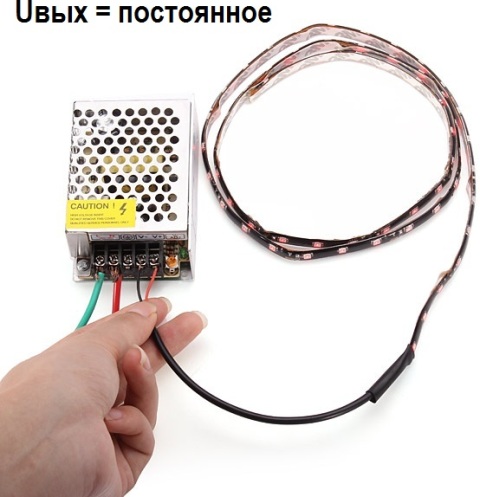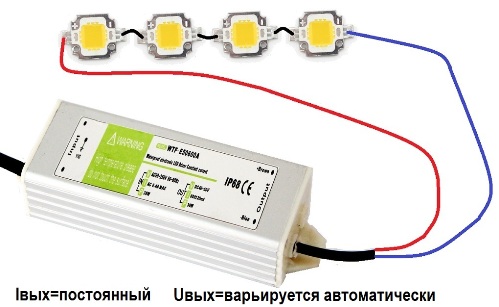Categories: All about LEDs
Number of views: 39827
Comments on the article: 0
How to choose the right driver for LEDs
The leading position among the most effective sources of artificial light is occupied today by LEDs. This is largely due to the quality of power sources for them. When working in conjunction with a correctly selected driver, the LED will maintain a steady brightness of light for a long time, and the life of the LED will be very, very long, measured in tens of thousands of hours.
Thus, a correctly selected driver for LEDs is the key to a long and reliable operation of the light source. And in this article we will try to reveal the topic of how to choose the right driver for the LED, what to look for, and what they are.

A driver for LEDs is called a stabilized power supply of constant voltage or direct current. In general, initially, an LED driver is stable current sourceBut today even DC voltage sources for LEDs are called LED drivers. That is, we can say that the main condition is stable DC power characteristics.
An electronic device (in fact, a stabilized pulse converter) is selected for the necessary load, whether it is a set of individual LEDs assembled in a serial chain, or a parallel set of such chains, or there can be a tape or even one powerful LED.
Stabilized DC power supply is good for powering LED stripsLED strips, or to power a set of several powerful LEDs connected in parallel one at a time - that is, when the nominal voltage of the LED load is known for sure, and you just need to select the power supply for the rated voltage at the corresponding maximum power.

Usually this does not cause problems, for example: 10 LEDs for a voltage of 12 volts, 10 watts each, will require a 100-watt power supply for 12 volts, designed for a maximum current of 8.3 amperes. It remains to adjust the output voltage using the adjustment resistor on the side, and you're done.
For more complex LED assemblies, especially when several LEDs are connected in series, you need not just a power supply with a stabilized output voltage, but a full-fledged LED driver - an electronic device with a stabilized output current. Here, the current is the main parameter, and the supply voltage of the LED assembly can automatically vary within certain limits.
For an even glow of the LED assembly, it is necessary to provide a rated current through all the crystals, however, the voltage drop across the crystals may differ for different LEDs (since the I – V characteristics of each of the LEDs in the assembly differ slightly), so the voltage on each LED will not be the same, but here the current should be the same.

LED drivers are produced mainly on power from a 220 volt network or from an on-board vehicle network of 12 volts. The output parameters of the driver are indicated as a range of voltages and rated current.
For example, a driver with an output of 40-50 volts, 600 mA will allow you to connect four 12-volt LEDs with a power of 5-7 watts in series. Approximately 12 volts will fall on each LED, the current through the series circuit will be exactly 600 mA, while the voltage of 48 volts falls into the operating range of the driver.
The driver for stabilized current LEDs is a universal power supply for LED assemblies, and its efficiency is quite high, and that's why.
The power of an LED assembly is an important criterion, but what determines this load power? If the current were not stabilized, then a significant part of the power would be dissipated by the alignment resistors of the assembly, that is, the efficiency would be low. But with a driver with current stabilization, alignment resistors are not needed, and the efficiency of the light source will turn out to be very high.
Drivers of different manufacturers differ among themselves in output power, protection class and used elemental base. As a rule, based on - pulsed PWM converter on a specialized chip, with stabilization of current output and with protection against short circuit and overload.
Food from a network of an alternating current of 220 volts or a direct current with a voltage of 12 volts. The simplest compact drivers with low-voltage power supply can be performed on one universal chip, but their reliability, due to simplification, is lower. However, such solutions are popular in auto-tuning.

When choosing a driver for LEDs, it should be understood that the use of resistors does not save from interference, as well as the use of simplified circuits with damping capacitors. Any voltage surges pass through resistors and capacitors, and the nonlinear current-voltage characteristic of the LED will necessarily be reflected in the form of a current jump through the crystal, and this is harmful to the semiconductor. Linear stabilizers are also not the best option in terms of protection from interference, in addition, the effectiveness of such solutions is lower.
Best of all, if the exact number, power, and circuit of the LEDs are known in advance, and all the assembly LEDs will be the same model and from the same batch. Then select the driver.
The case must indicate the range of input voltages, output voltages, and rated current. Based on these parameters, select the driver. Pay attention to the enclosure protection class.
For research tasks, for example, frameless LED drivers are suitable, such models are widely represented on the market today. If it is required to place the product in the housing, the housing can be made by the user independently.
See also at bgv.electricianexp.com
:
